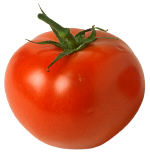 Subscribe to my feed for ingredients
Subscribe to my feed for ingredients  Add to My Yahoo
Add to My Yahoo 
© Copyright 1995-2023, Clay Irving <clay@panix.com>, Manhattan Beach, CA USA
 Subscribe to my feed for ingredients
Subscribe to my feed for ingredients  Add to My Yahoo
Add to My Yahoo
Tomato Characteristics
Pronounced: tuh-MAY-toh; tuh-MAH-toh
The tomato and the chile are the most common used ingredients in salsas. The tomato is the fruit of the tomato plant, a member of the nightshade family, which includes Tomatillo, Eggplant, and Chayote. The nightshade family also includes many species that produce poisonous alkaloids including tobacco (produces nicotine), deadly nightshade (produces atropine), and mandrake (produces hyoscymine, used for motion sickness and as a preoperative anesthetic).
It is thought that the tomato originated in South America (probably Peru). It was domesticated by the Incas was introduced to Mexico where it was given the indian name, xicotomatl, now known in Mexico as jitomate. Spanish explorers introduced the tomato to Europe, but most Europeans were relucant to eat the tomato -- Since the tomato is a member of the nightshade family, it was commonly thought to be poisonous. On the contrary, today the tomato is known as the primary source of Lycopene, an antioxidant carotenoid in the same family as beta carotene, which gives the tomato its red color. Lycopene may help protect against diseases such as cancer and heart disease. A tomato has high levels of vitamin C, folate, lycopene, and is low in calories with an average tomato having about 30 calories.
The original wild, Incan tomato was a small cherry-sized berry with many ruffles and ridges. In the late 1800's, a horticulturist named Alexander W. Livingston spent many years attempting to develop a commercial tomato with a smooth contour, larger uniform size and better flavor. He suceeded in 1870 with a variety of tomato called the Paragon, and tomato culture began at once to be a great enterprise of the county. Today, tens of millions of tons of tomatos are havested in the US and Mr. Livingston's home town of Reynoldsburg, Ohio is generally recognized as the birthplace of the tomato. Incredibly, each man, woman and child in America consumes almost 80 pounds of tomatoes every year.
Many people don't realize the tomato is the fruit of the tomato plant. By definition, a fruit is the fleshy, seed-bearing part of a plant. A vegetable is part of various types of plants eaten as food. In 1893, however, the United States Supreme Court ruled in the case of Nix v. Hedden that because the tomato was used as a vegetable - eaten with the main part of the meal instead of at the end - it should be legally classified as such, and therefore be subject to the same tariffs as other vegetables when imported.
When a tomato ripens, the fruit changes color, and develops flavor. The color changes is caused by loss of green chlorophyll and conversion of carotenoids into red lycopene pigments. The tomato naturally produces ethylene, a colorless gas with a sweet ether-like odor. Ethylene is a ripening hormone for several fruits, including apples, avocados, bananas, melons, peaches, and pears (NOTE: these ethylene producing fruits should never be stored with ethylene-sensitive vegetables like broccoli, cauliflower, and leafy greens like cabbage and lettuce). Commercial tomatoes are often picked prior to a ripe maturity and ripened later by "gassing" with ethylene. Ethylene, however, can not change the color of the tomato. This produces the light reddish-pink, tasteless tomatoes commonly found in grocery stores. Personally, I have no use for these tomatoes.
Use fresh, vine-ripened tomatoes when available. Ripe tomatoes should be stored at room temperature and used within a few days. They should never be refrigerated -- Refrigerating kills the flavor, the nutrients, the texture. Tomatoes ripen from inside out with the center of the tomato always riper than the skin. The ideal temperature for tomatoes is somewhere between 55°-70°. At this temperature the tomato will ripen inside and out. The tomato will have a full flavor and stay moist and plump.
Varieties


|